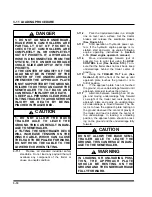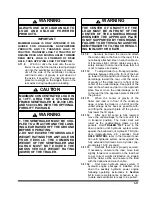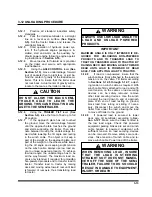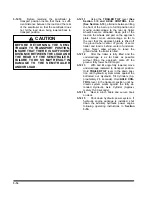
3-11 LOADING PROCEDURE
DANGER
1. DO NOT GO NEAR UNDERCAR-
RIAGE WHEN CAM ROLLERS ARE
PARTIALLY OUT OF POCKETS.
CHECK THAT CAM ROLLERS ARE
COMPLETELY IN, OR COMPLETELY
OUT OF POCKETS. IF A HYDRAULIC
HOSE IS DISCONNECTED FROM THE
SYSTEM, THE UNDERCARRIAGE
COULD SLIDE ABRUPTLY INTO THE
POCKETS.
2. THE CENTER OF GRAVITY OF THE
LOAD MUST BE IN FRONT OF THE
CENTER OF THE UNDERCARRIAGE
WHENEVER THE APPROACH PLATE
IS NOT SUPPORTED BY THE GROUND.
FAILURE TO DO THIS CAN CAUSE THE
SEMITRAILER TO TILT BACK AND
CAN RESULT IN INJURY OR DEATH.
3. KEEP ALL PERSONS CLEAR WHILE
TILTING TRAILER TO AVOID SERIOUS
INJURY OR DEATH BY BEING
PINCHED IN TRAILER BED.
CAUTION
1. DO NOT ALLOW THE BACK
TRAILER AXLE TO LEAVE THE
GROUND. THIS CAN RESULT IN DAM-
AGE TO SEMITRAILER.
2. TILTING THE SEMITRAILER DECK
WILL INCREASE TENSION ON THE
WINCH CABLE, WHICH CAN CAUSE
THE LOAD TO BE PULLED FORWARD.
DO NOT HOOK THE CABLE TO THE
LOWER DECK WHEN TILTING.
3-11.1
Practice all standard industrial safety
standards. Do not load any payload that will
overload any component of the trailer or
cause an unsafe condition.
3-11.2
Park the tractor/semitrailer in a straight
line on level even surface. Set the tractor
brakes and release the semitrailer brakes
(See Figure 3-5).
3-11.3
Start operation of hydraulic power sys-
tem. If the hydraulic engine package is in-
stalled, start and warm up engine following
engine operating instructions in
Section
3-16. (Read engine operator’s manual.)
3-11.4
Move undercarriage forward (out of
pockets) five to eight feet using the
AXLE
CONTROL
lever
(See Section 3-10)
. To in-
sure that the trailer does not rock back, keep
undercarriage behind the trailer center of
gravity.
3-11.5
Using the
TRAILER TILT
lever
(See
Section 3-9)
tilt the front of the bed up until
approach plate touches the ground or is to
full tilt position.
3-11.6
If the approach plate has not touched
the ground, move undercarriage forward until
approach plate just touches the ground.
3-11.7
Alternate between lowering bed tilt an-
gle and moving undercarriage fully forward
so weight of the trailer bed rests partly on
approach plate and partly on undercarriage
as undercarriage is moved forward. The ob-
ject is to have the approach plate resting on
the ground whenever the center of gravity of
the trailer and load is behind the center of
the undercarriage. In loading or unloading
position, the approach plate should be rest-
ing on the ground and the undercarriage fully
forward.
CAUTION
DO NOT ALLOW THE BACK SEMI-
TRAILER AXLE TO LEAVE THE
GROUND. THIS CAN RESULT IN DAM-
AGE TO THE SEMITRAILER.
WARNING
IN LOADING OR UNLOADING POSI-
TION, THE APPROACH PLATE
SHOULD BE RESTING ON THE
GROUND AND THE UNDERCARRIAGE
FULLY FORWARD.
3-10
Summary of Contents for 317C
Page 8: ......
Page 14: ...3 2 Figure 3 1 Front Trailer Terminology Figure 3 2 Rear Trailer Terminology...
Page 18: ......
Page 24: ...3 12 Figure 3 5 Steps for Loading and Unloading...
Page 30: ...3 18 Figure 3 10 Dock Leveler Operation...
Page 34: ...3 22 Figure 3 12 Front Extension Bulkhead...
Page 36: ...3 24 Figure 3 13 Rear Impact Guard and Antilock Brake System...
Page 40: ...4 2 Figure 4 1 Lubrication Points...
Page 45: ...4 7 Figure 4 2 317C 318C 319C Wiring Diagram...
Page 46: ...4 8 Figure 4 3 Remote Wiring Diagram...
Page 52: ...4 14 Figure 4 6 Checking Axle Alignment Figure 4 7 Examples of Camber...
Page 56: ...4 18 Figure 4 10 Axle and Brake Assembly...
Page 64: ...4 26 Figure 4 16 Mounting Tires and Wheels Figure 4 17 Stud Tightening Sequence...
Page 67: ...4 29 Figure 4 18 Dock Leveler Leg Assembly...
Page 68: ......
Page 78: ...5 10 NOTES...
















































